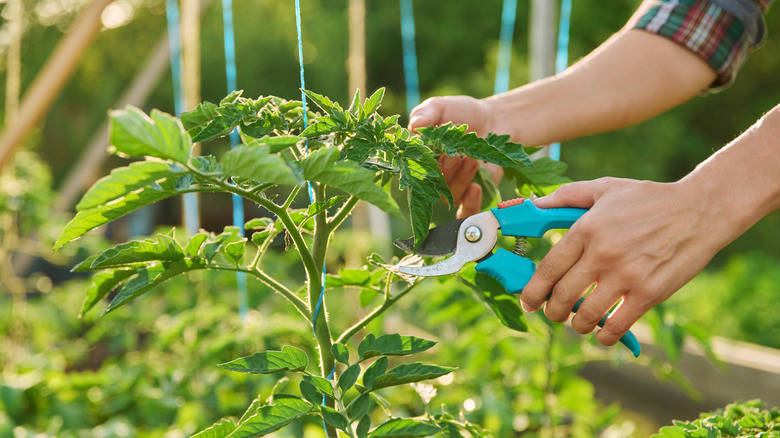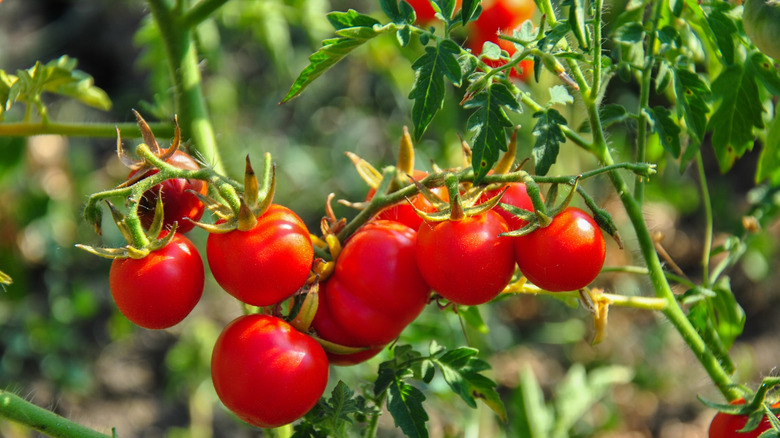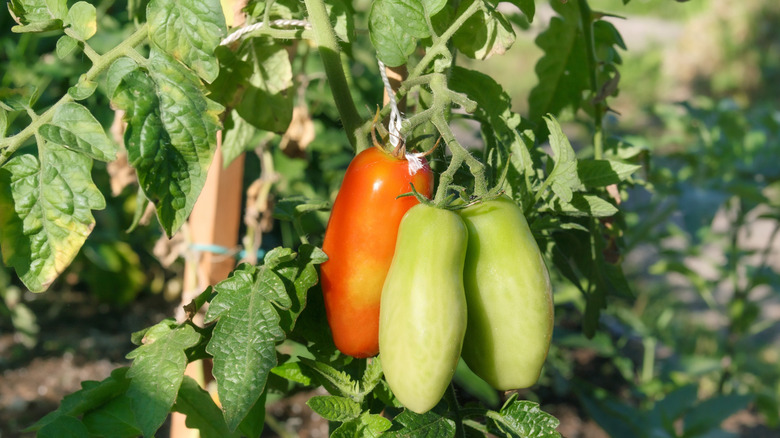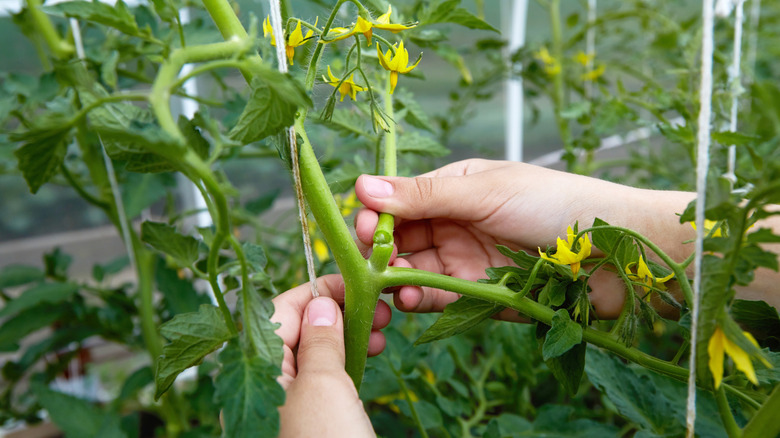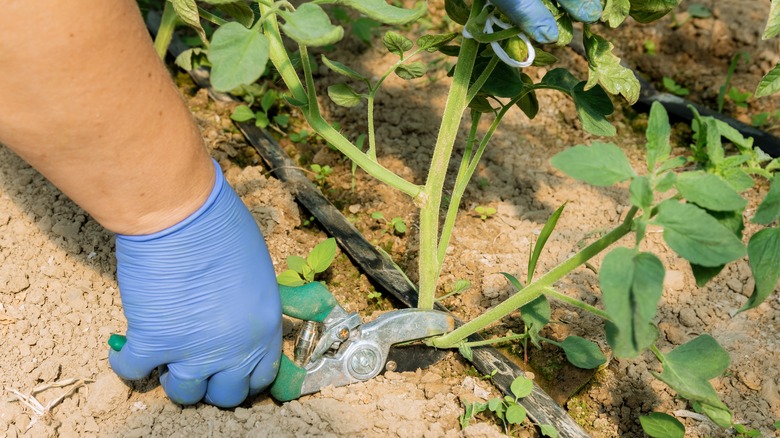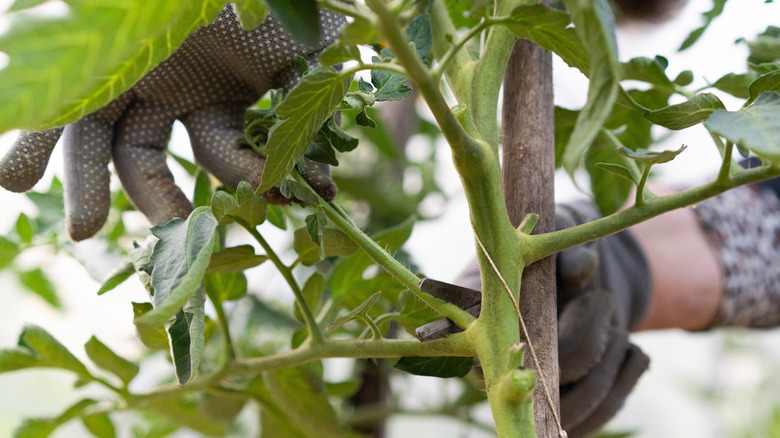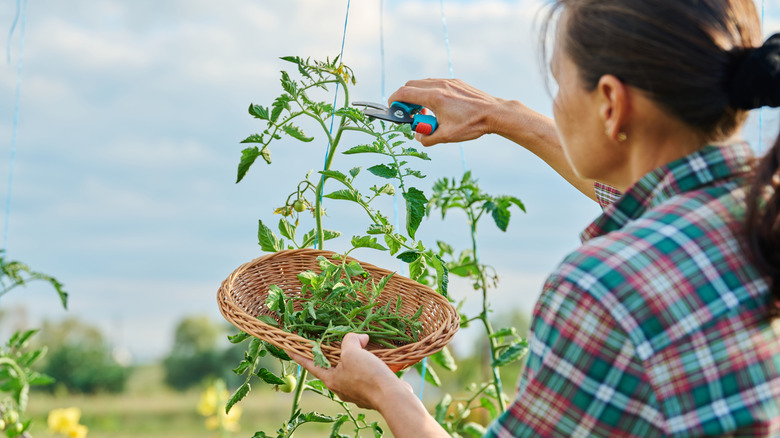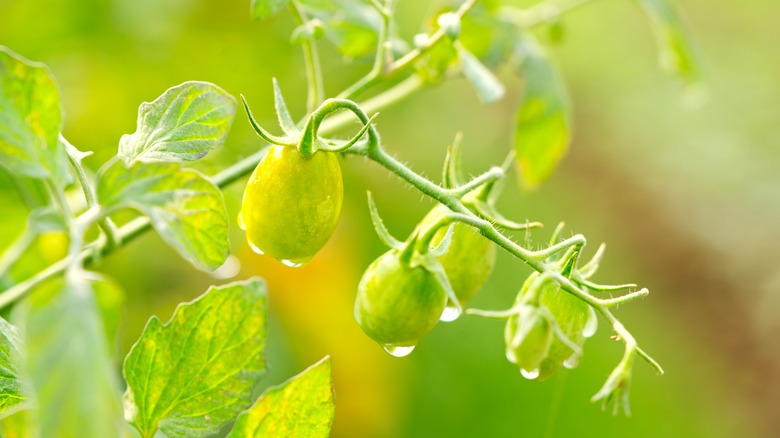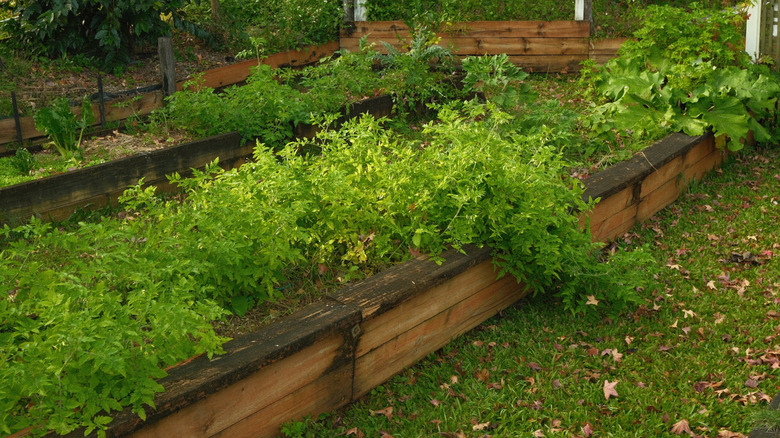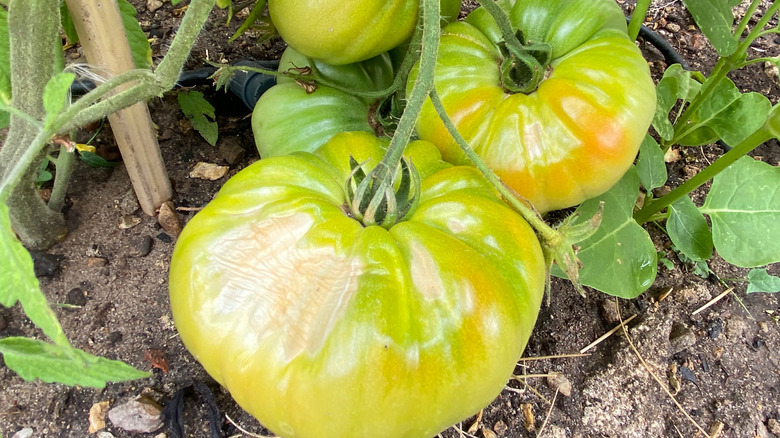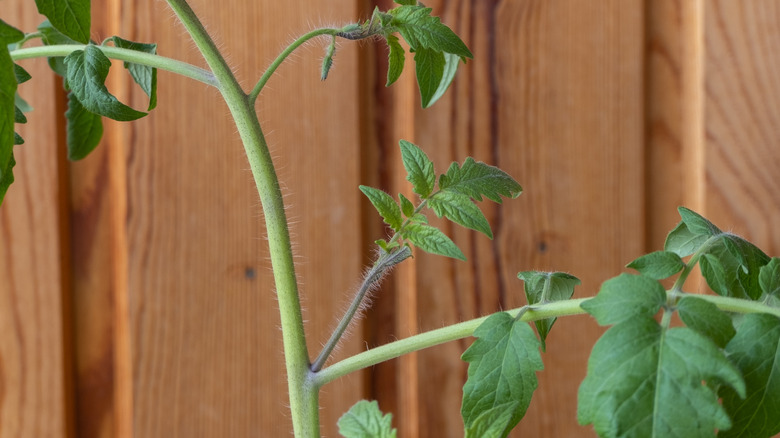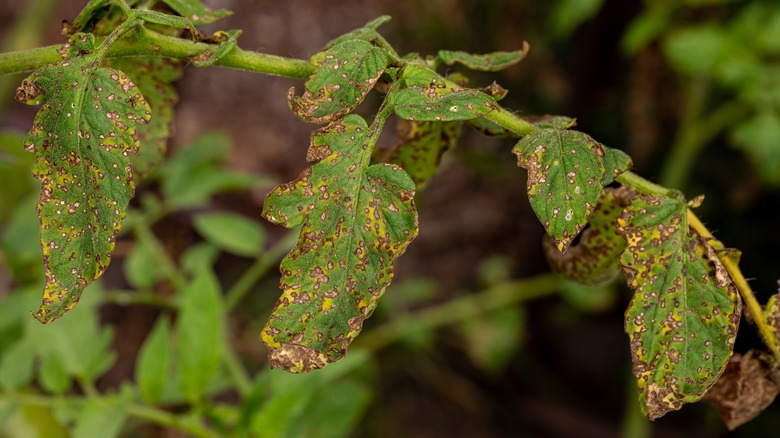The Biggest Mistakes You Can Make When Pruning Tomato Plants
We may receive a commission on purchases made from links.
Tomato plants can make an excellent addition to a vegetable garden. They're relatively easy to grow and can produce a lot of fruit (potentially over 15 pounds per plant). However, there are still some mistakes home gardeners make when planting tomatoes and caring for them. Many of these common mistakes center around pruning. People often don't understand why, when, or how to prune. Incorrect pruning practices can threaten the health of a plant, decrease the number of tomatoes it yields, and cause other problems.
Whether you're new to growing tomatoes in your garden or just want a quick refresher on pruning, you've come to the right place. Ahead, we've compiled a list of some of the biggest mistakes people make when pruning their tomato plants. In addition to explaining why each of these mistakes is something you'll want to avoid, we'll also share some information on what you should do instead to keep your plants healthy and to make sure you're able to enjoy a bountiful harvest.
Assuming indeterminate tomato plants don't need to be pruned at all
If you're new to growing tomato plants, you might not think that it'll be necessary to prune them. However, following this assumption will be a detrimental mistake, especially if you are growing indeterminate tomato plants in your garden, such as cherry tomatoes. Before we get into why pruning is one of the handiest hacks to remember when growing tomato plants, let's take a quick step back to discuss the differences between tomatoes with an indeterminate or determinate growth pattern. While determinate varieties will not continue growing after reaching a terminal bud (which is predetermined), indeterminate varieties will continue to grow throughout the season. Failing to prune these varieties can cause them to be overly top-heavy (which can result in breakages), and produce sprawling growth, which can allow for too much moisture to accumulate around the base.
On the other hand, by properly pruning indeterminate tomato plants, you'll help ensure that the vines stay healthy, don't break, and receive the sun that they need to ripen the fruits. Pruning will help prevent excess moisture from lingering at the base of the plants, which could leave them more susceptible to various pests and diseases, such as root rot.
Heavily pruning determinate tomato plants
While indeterminate tomato plants will need a lot of pruning, generalizing this rule and assuming that varieties with a determinate growth pattern will need the same will be a mistake. If you prune a determinate tomato too heavily, you might decrease how much fruit it will be able to produce by reducing the total size of the plant. Plus, these varieties have a terminal bud, and they will not grow beyond this point and become top-heavy like indeterminate varieties. Common indeterminate varieties include Roma, Celebrity, and Rugters.
Instead, determinate tomato plants require very minimal pruning. The main thing you should do is to pinch off any suckers that grow under the first cluster of flowers. This step will help ensure that there is adequate airflow around the base of the plant to prevent excess moisture from building up and causing issues with diseases or pests. It will also direct more of the plant's resources to fruit production. Light pruning along the canopy of some determinate tomatoes may also be done occasionally to decrease density and allow light and air to better reach the plant.
Allowing suckers to get too big before removing them
When you're thinking about how to prune your tomatoes, one of the biggest mistakes you can make is letting the suckers grow for a bit instead of removing them promptly. The suckers are the little shoots that sprout from the part of the plant where the stem and one of the leaf branches connect. If you don't prune them, these suckers will continue to grow. While they can develop fruit once having grown into branches, it is still generally a mistake to leave them in place. The problem with leaving suckers is that the plant will have to focus its energy in too many different directions. With less energy to dedicate to growing the tomatoes on the main branches, you'll likely end up with smaller fruit. Moreover, the fruit may take longer to ripen as the plant has to spread its energy over too many areas areas. Finally, consider what shape the plant will take if you allow all of those suckers to continue growing. It may become impossible to manage, overly sprawled out, or top-heavy.
Instead, you'll want to remove suckers as they emerge to prevent the plant from wasting any energy on their growth. Pruning these off is a simple process, especially when you act quickly. They're thin, and you can normally just pinch them off. If the canopy is quite thin, you can leave a few suckers to develop into branches and provide shade for the fruit later (too much sun exposure can scald tomatoes). Like we just mentioned for determinate tomatoes, you only have to remove the suckers up to the first flower cluster. For indeterminate varieties, you can pinch off suckers from all along the stem.
Removing the strongest sucker from the plant
There's one key exception to the advice we just shared above about removing suckers. While you want to remove the overwhelming majority of the suckers from the plant, removing the first one that is beneath the fruit cluster towards the bottom of the plant will be a mistake. Out of all the suckers that your tomato plant will produce, this one is the strongest. If you remove it, you're robbing the plant of the chance to create a second sturdy stem that will produce more fruit to add to your yield.
So, as you're examining your plants and pruning or pinching off the suckers, always take note of which one is just below the lowest cluster of flowers. Leave this one alone, and focus your efforts on pinching off the rest so that they don't steal the energy the plant needs. When you leave this strong sucker to grow and develop, then you'll be rewarded with an additional stem and even more vibrant red tomatoes.
Failing to cleanly snap or cut the sucker
Whether you're pinching off the suckers or cutting them off with a pair of pruning shears, you must be careful to avoid leaving a jagged edge. If the cut (or pinch) you make is not clean, then it will leave the plant vulnerable to various potential problems. The plant will need to devote more energy to trying to heal the wound. This can draw energy away from supporting new growth and fruit production. Additionally, various diseases can potentially enter through open wounds.
Always work carefully when pruning. If you're pinching off a sucker, take care to ensure that it snaps cleanly. If you're using gardening snips for larger suckers, ensure that they are sharp. Dull snips won't cut cleanly and may force you to tear off the sucker, resulting in an open wound. Your pruning shears will also work better with a little help from WD-40. When they're well lubricated, you won't need to worry about them getting stuck and pulling at the sucker instead of cutting it off.
Avoiding larger wounds than necessary is another reason why it is important to prune suckers regularly before they get a chance to grow in size. Even if you're careful to cleanly cut off the bigger suckers, the reality is that there will still be a larger wound that the plant needs to devote energy towards healing.
Failing to wash your hands or sanitize pruning shears between plants
If you have multiple tomato plants in your garden, you're likely going to prune them all at the same time. However, you'll want to be careful to avoid being so quick and efficient that you move from clipping one plant to the next without stopping to clean your hands and your pruning shears. Otherwise, if the plant that you last trimmed has a disease, you may inadvertently spread it to the other plants in your garden. Remember, many diseases can enter through open wounds on a plant. Every time you cut or pinch off a sucker, you're creating a wound, even if it is only a small one.
To avoid transmitting diseases between your tomato plants, it is crucial to make sure that anything that comes into contact with one plant is properly cleaned before it touches another plant. The first thing you need to know is how to clean and disinfect your gardening tools, such as your pruning shears. You can sanitize the shears by dipping them in rubbing alcohol, such as the McKesson Isopropyl Rubbing Alcohol 70%, or wiping them down with a rag dipped in disinfectant.
Additionally, you'll want to wash your hands so they don't spread disease, either. You can consider creating a handy handwashing station for your garden by adding soapy water to an old laundry detergent dispenser and placing it in a convenient location. Alternatively, you'll need to go wash your hands with soap at a nearby faucet. If you smoke or use any tobacco products, it can be even more important to wash your hands before you start pruning and again after any smoke breaks you take. This is because tomatoes can become infected with Tobacco Mosaic Virus.
Pruning at the wrong time
You might think that it doesn't matter when you prune your tomato plants, as long as you get it done. However, pruning under certain conditions can leave tomato plants more susceptible to disease or impede their ability to grow properly. Diseases are more likely to spread if there is a lot of moisture present. Therefore, you shouldn't clip tomato plants after watering them or immediately following a rain shower. Pruning in overly hot weather isn't good either. It can put the plants under undue stress, leaving them more susceptible to threats from insects, diseases, and more.
To avoid threatening the health of your plant (and its fruit yield), choose your pruning time carefully. Opt for a time when the plant is dry and the temperatures aren't overly hot. Pruning in the morning is something that many experts recommend. Within a few hours of the sun coming up, any dew should have evaporated, but the temperatures won't be as hot as during the afternoon hours.
Leaving too many leaves on the plant
If you don't prune the leaves of your tomato plant, this can result in thick foliage that reduces airflow and light penetration. Less airflow and light penetration can mean more moisture around the base of the plant. This is a recipe for disease, so make sure you keep on top of removing excess foliage, especially if you're gardening in a humid area.
The key to pruning the leaves is knowing where you should cut and how much you should remove. As we just mentioned, cutting the leaves that are close to the base (those under the first cluster of flowers) is important for improving airflow and preventing diseases. As for the leaves higher up on the plant, these will require lighter pruning. You just want to remove enough to let some sunlight in, without removing so many (especially from the top) that you end up restricting the growth of the plant.
Pruning too close to harvesting
While keeping up with regular pruning is important during much of the growing season, you also must know when it is time to stop. If you continue to prune the plants through the harvesting time, you might be disappointed with the fruit you pick. The tomatoes will be more likely to be damaged from sunscald. This can cause their red color to be less vibrant or even result in visible injuries to the fruit.
The reason you shouldn't continue to prune through harvest time is that removing too much of the foliage growing over the fruits leaves them exposed to more direct sunlight. You want some sunlight as the tomatoes are growing and ripening, but too much when they're almost ready can be a bad thing. Instead, as your harvesting date is approaching (about two weeks away), put down the shears and let those leaves continue to grow. This will allow them to create a better canopy that will block enough sunlight to shield the fruit against sunscald.
Over-pruning the plants
As you probably know by now, pruning tomato plants is one of the essential tasks you'll need to complete if you're growing an indeterminate variety. Knowing how important it is, you may get carried away and end up over-pruning the plant. This will be a mistake that may trigger unnecessary stress, a decreased yield, and other issues. Over-pruning a tomato plant and removing too many leaves can result in high levels of sun exposure to fruits and reduced photosynthesis and energy production.
So, how are you supposed to navigate this fine line between removing enough excess growth to promote better airflow and direct energy towards the fruit — without overdoing things and compromising the plant? Fortunately, there is a general rule that many gardening experts recommend. Never remove more than one-third of the leaves at any time. Pruning back more than a third will cause unnecessary stress to the plant, and it can also ultimately mean that there won't be enough leaf cover when the tomatoes start ripening, resulting in the aforementioned sunscald.
Leaving diseased or damaged portions on the plant instead of pruning them
There are many common diseases and problems garden tomatoes can develop, and as we mentioned earlier, these diseases can travel between the plants. However, non-sanitized pruning shears and dirty hands aren't the only vehicles through which the diseases can be spread. They can also spread through the soil. And, if you prune a diseased section from a plant and leave it on the ground, you increase the chances that the fungus or pathogen causing the disease will get into the soil and, eventually, infect one of the other nearby plants.
To minimize the spread of diseases, always properly dispose of the infected clippings. The best method of disposal can vary based on which disease your plants are infected with. To be safe and reduce the risk of the disease spreading, you can consider bringing the clippings to a city composting site. Unlike home composting sites, which may not get hot enough to kill all pathogens, these commercial sites reach higher temperatures. Alternatively, you can consider burying certain infected clippings. You'll need to choose a spot away from your vegetable garden and dig a hole that is at least 1 foot deep.
